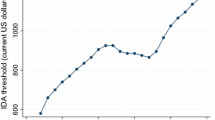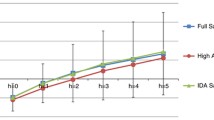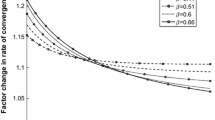Abstract
Recent literature proliferates with studies examining the ‘curses’ of aid, or ‘aid-dependent’ relationships. This latter term, while widely used, is surprisingly under-developed conceptually and has generally been understood as some nebulous ‘large’ threshold of aid. To conceptualise the term more concretely, this paper draws on the welfare dependence literature to suggest a complementary understanding of aid dependence based on aid persistence, specifically the duration of non-declining aid receipt. The paper finds evidence that this aid dependence is associated with negative macroeconomic performance, suggesting that more useful understandings of aid dependence may be predicated as much on the duration, as the quantity, of aid receipt.



Similar content being viewed by others
References
Agénor, Pierre-Richard and Joshua Aizenman (2010) ‘Aid Volatility and Poverty Traps’, Journal of Development Economics 91(1): 1–7.
Antingi-Ego, Michael (2005) ‘Budget Support, Aid Dependency, and Dutch Disease: The Case of Uganda’, in Stefan Koeberle, Zoran Stavreski and Jan Walliser, eds, Budget Support as More Effective Aid? Recent Experiences and Emerging Lessons, Washington: World Bank, publication no. 35967.
Arellano, Christina, Ales Bulir, Timothy Lane and Leslie Lipschitz (2009) ‘The Dynamic Implications of Foreign Aid and its Variability’, Journal of Development Economics 88: 87–102.
Awokuse, Titus O (2007) ‘Causality Between Exports, Imports, and Economic Growth: Evidence from Transition Economies’, Economics Letters 94(3): 389–95.
Azam, Jean-Paul, Shantayanan Devarajan and Stephen O’Connell (1999) ‘Aid-Dependence Reconsidered’, working paper no. 189, Oxford: Centre for the Study of African Economics.
Bandyopadhyay, Subhayu and E. Katarina Vermann (2013) ‘Donor Motives for Foreign Aid’, Federal Reserve Bank of St. Louis Review 95(4): 327–36.
Barbier, Edward B (2004) ‘Agricultural Expansion, Resource Booms and Growth in Latin America: Implications for Long-Run Economic Development’, World Development 32(1): 137–57.
Besley, Timothy and Torsten Persson (2014) ‘Why do Developing Countries Tax so Little?’, Journal of Economic Perspectives 28(4): 99–120.
Boone, Peter (1996) ‘Politics and the Effectiveness of Foreign Aid’, European Economic Review 40(2): 289–329.
Brambor, Thomas, William Roberts Clark and Matt Golder (2006) ‘Understanding Interaction Models: Improving Empirical Analyses’, Political Analysis 14(1): 63–82.
Brautigam, Deborah and Stephen Knack (2004) ‘Foreign Aid, Institutions, and Governance in Sub–Saharan Africa’, Economic Development and Cultural Change 52(2): 255–85.
Brazys, Samuel (2010) ‘Dutch Disease in the Western Pacific: An Overview of the FSM Economy Under the Amended Compact of Free Association’, Pacific Economic Bulletin 25(3): 24–39.
Brazys, Samuel (2014) ‘Outside Looking in: Non-Accession to the WTO’, Cambridge Review of International Affairs 27(4): 644–65.
Brazys, Samuel (2016) ‘Aid and Governance: Negative Returns?’, European Journal of Development Research 28(2): 294–313.
Bruno, Giovanni S. F. (2005) ‘Approximating the Bias of the LSDV Estimator for Dynamic Unbalanced Panel Data Models’, Economics Letters 87(3): 361–66.
Bulir, Ales and A. Javier Hamann (2008) ‘Volatility of Development Aid: From the Frying Pan into the Fire?’, World Development 36(10): 2048–66.
Burnside, Craig and David Dollar (2000) ‘Aid, Policies and Growth’, American Economic Review 90(4):847–68.
Busse, Matthias and Steffen Groning (2009) ‘Does Foreign Aid Improve Governance?’, Economics Letters 104(2): 76–78.
Campbell, Ian C. (1992) ‘A Historical Perspective on Aid and Dependency: The Example of Tonga’, Pacific Studies 15(3): 59–75.
Cardoso, Fernando Henrique (1977) ‘The Consumption of Dependency Theory in the United States’, Latin American Research Review 12(3): 7–24.
Carter, Patrick (2013) ‘Does Foreign Aid Displace Domestic Taxation?’, Journal of Globalization and Development 4(1): 1–47.
Carter, D. B. and R. W. Stone (2015) ‘Democracy and Multilateralism: The Case of Vote Buying in the UN General Assembly’, International Organization 69(1): 1–33.
Castel-Branco, C. N. (2008) ‘Aid Dependency and Development: A Question of Ownership? A Critical View’, working paper no. 01/2008, Maputo, Mozambique: Instituto de Estudos Sociais e Economicos.
Catrinescu, Natalia, Miguel Leon-Ledesma, Matloob Piracha and Bryce Quillin (2009) ‘Remittances, Institutions, and Economic Growth’, World Development 37(1): 81–92.
Chow, Gregory C. and Kui‐Wai Li (2002) ‘China’s Economic Growth: 1952–2010’, Economic Development and Cultural Change 51(1): 247–56.
Clemens, Michael A., Steven Radelet, Rikhil R. Bhavnani and Samuel Bazzi (2012) ‘Counting Chickens when they Hatch: Timing and the Effects of Aid on Growth’, Economic Journal 122(561): 590–617.
Clist, Paul and Oliver Morrissey (2011) ‘Aid and Tax Revenue: Signs of a Positive Effect Since the 1980s’, Journal of International Development 23: 165–280.
Collier, Paul (1999) ‘Aid Dependency: A Critique’, Journal of African Economics 8(4): 528–45.
Copelovitch, Mark S. and David Ohls (2012) ‘Trade, Institutions, and the Timing of GATT/WTO Accession in Post-Colonial States’, Review of International Organizations 7(1): 81–107.
Crocker, Chester (1968) ‘External Military Assistance to Sub–Saharan Africa’, Africa Today 15(2): 15–20.
Dalgaard, Carl–Johan, Henrik Hansen and Finn Tarp (2004) ‘On the Empirics of Foreign Aid and Growth’, Economic Journal 114: F191–F216.
Djankov, Simeon, Jose Montalvo and Marta Reynal-Querol (2009) ‘Aid with Multiple Personalities’, Journal of Comparative Economics 37(2): 217–29.
Doucouliagos, Hristos and Martin Paldam (2008) ‘The Aid Effectiveness Literature: The Sad Results of 40 Years of Research’, Journal of Economic Surveys 23(3): 433–61.
Dreher, Axel, Peter Nunnenkamp and Rainer Thiele (2008) ‘Does US Aid Buy UN General Assembly Votes?’, Public Choice 136: 139–64.
Dunning, Thad (2004) ‘Conditioning the Effects of Aid: Cold War Politics, Donor Credibility, and Democracy in Africa’, International Organization 58(2): 409–23.
Easterly, William (2003) ‘Can Foreign Aid Buy Growth?’, Journal of Economic Perspectives 17(3):23–48.
Easterly, William (2007) ‘Was Development Assistance a Mistake?’, American Economic Review 97(2): 328–32.
Godfrey, Martin, Chan Sophal, Toshiyasu Kato, Long Vou Piseth, Pon Dorina, Tep Saravy, Tia Savora and So Sovannarith (2002) ‘Technical Assistance and Capacity Development in an Aid-Dependent Economy: The Experience of Cambodia’, World Development 30(3): 355–73.
Griffin, Keith (1991) ‘Foreign Aid After the Cold War’, Development and Change 22(4): 645–85.
Gupta, Sanjeev, Benedict Clements, Alexander Pivovarsky and Erwin Tiongson (2003) ‘Foreign Aid and Revenue Response: Does the Composition of Aid Matter?’, working paper no. 03/176. Washington: International Monetary Fund.
Hailu, Degol and Aadmasu Shiferaw (2012) ‘Macroeconomic Determinants of Exit from Aid-Dependence’, working paper no. 90, Brasilia, DF, Brazil: International Policy Centre for Inclusive Growth.
Hansen, Henrik and Finn Tarp (2001) ‘Aid and Growth Regressions’, Journal of Development Economics 64(2): 547–70.
Hayter, Teresa (1971) Aid as Imperialism, Harmondsworth: Penguin Books.
Jacobellis v. Ohio (1964) 378 U.S. 184. Supreme Court of the United States of America.
Keohane, Robert (1967) ‘The Study of Political Influence in the General Assembly’, International Organization 21(2): 221–37.
Knack, Stephen (2001) ‘Aid-Dependence and the Quality of Governance: Cross–Country Empirical Tests’, Southern Economic Journal 68(2): 310–29.
Lensink, Robert and Howard White (1999) Aid Dependence: Issues and Indicators, Stockholm: Almqvist & Wiksell International.
Lensink, Robert and Howard White (2001) ‘Are There Negative Returns to Aid?’, Journal of Development Studies 37(6): 42–65.
McKinley, Robert D. and Richard Little (1979) ‘The US Aid Relationship: A Test of the Recipient Need and the Donor Interest Models’, Political Studies 27(2): 236–50.
Meernik, James, Eric Krueger and Steven Poe (1998) ‘Testing Models of US Foreign Policy: Foreign Aid During and After the Cold War’, Journal of Politics 60(1): 63–85.
Mosley, Paul (1980) ‘Aid, Savings and Growth Revisited’, Oxford Bulletin of Economics and Statistics 42(2): 79–95.
Moss, Todd and Arvind Subramanian (2005) ‘After the Big Push? Fiscal and Institutional Implications of Large Aid Increases’, working paper no. 71, Washington: Center for Global Development.
Moss, Todd, Gunilla Pettersson and Nicolas van de Walle (2006) ‘An Aid-Institutions Paradox? A Review Essay on Aid Dependency and State Building in Sub-Saharan Africa’, working paper no. 74, Washington: Center for Global Development.
Nickell, Stephen (1981) ‘Biases in Dynamic Models with Fixed Effects’, Econometrica: Journal of the Econometric Society 48: 1417–26.
Nord, Roger, Michael Mered, Nisha Agrawal and Zafar Ahmed (1993) ‘Structural Adjustment, Economic Performance, and Aid Dependency in Tanzania’, working paper no. WP/93/66, Washington: International Monetary Fund.
Rajan, Raghuram and Arvind Subramanian (2008) ‘Aid and Growth: What Does the Cross–Country Evidence Really Show?’, Review of Economics and Statistics 90(4): 643–65.
Rajan, Raghuram and Arvind Subramanian (2011) ‘Aid, Dutch Disease, and Manufacturing Growth’, Journal of Development Economics 94: 106–18.
Riddell, Roger (1996) ‘Aid Dependency’, in Gus Edgren, Roger Riddell and Rehman Sobhan, eds, Aid Dependency: Causes, Symptoms and Remedies, Project, 2015, 23–110, Stockholm: Swedish International Development Cooperation Agency.
Roodman, David (2009) ‘How to do xtabond2: An Introduction to Difference and System GMM in Stata’, Stata Journal 9(1): 86–136.
Smith, Ron P. (2014) ‘The Economic Costs of Military Conflict’, Journal of Peace Research 51(2): 245–56.
Sobhan, Rehman (1981) ‘Bangladesh and the World Economic System: The Crisis of External Dependence’, Development and Change 12(3): 327–47.
Sobhan, Rehman (1996) ‘Aid Dependence and Donor Policy’, in Gus Edgren, Roger Riddell and Rehman Sobhan, eds, Aid Dependency: Causes, Symptoms and Remedies, Project, 2015, 111–245, Stockholm: Swedish International Development Cooperation Agency.
Svensson, J. (1999) ‘Aid, Growth and Democracy’, Economics and Politics 11(3): 275–97.
Svensson, J. (2000) ‘When is Foreign Aid Policy Credible? Aid Dependence and Conditionality’, Journal of Development Economics 61(1): 61–84.
Swedish International Development Authority (SIDA) (1996) Aid Dependency: Causes, Symptoms and Remedies, Project, 2015, Stockholm: Swedish International Development Cooperation Agency.
Wang, Te-Yu (1999) ‘US Foreign Aid and UN Voting: An Analysis of Important Issues’, International Studies Quarterly 43(1): 199–210.
Younger, Stephen (1992) ‘Aid and the Dutch Disease: Macroeconomic Management when Everybody Loves You’, World Development 20(11): 1587–97.
Acknowledgements
The author thanks the participants of the International Studies Association 2013 annual conference and the UCD School of Politics and International Relations Seminar Series for comments and suggests on earlier drafts of this manuscript. All errors remain his own.
Author information
Authors and Affiliations
Corresponding author
Appendices
Appendix 1: Data
The data for this project were gathered from two sources. Official development assistance was gathered from the OECD creditor reporting system (CRS) database available at http://stats.oecd.org/Index.aspx?DatasetCode=CRSNEW. Gross domestic product, per capita GDP, fixed capital formation, crop yield, battle deaths, and life expectancy were gathered from World Bank’s WDI database available at http://data.worldbank.org/data-catalog/world-development-indicators. All regressions were run in STATA 13. Missing data were dropped from the regression. For a full list of missing data points, or for a full replication dataset, please contact the author.
See Table 4.
The data includes any country that received ODA at any period from 1970 to 2005. These countries include (years of complete data missing in parentheses): Afghanistan (1970–2005), Algeria, Angola (1970–1985), Antigua and Barbuda (1970–1980), Argentina, Armenia (1970–1990), Aruba (1970–2005), Azerbaijan (1970–1990), Bahamas (1970–1980), Bahrain (1970–2005), Bangladesh (1970), Barbados, Belarus (1970–2000), Belize (1970–1980), Benin, Bermuda (1970–2005), Bhutan (1970–1985), Bolivia, Botswana, Brazil, Brunei (1970–1985), Burkina Faso, Burundi, Cambodia (1970–1995), Cameroon, Cape Verde (1970–1985), Cayman Islands (1970–2005), Central African Rep., Chad, Chile, Colombia, Comoros (1970–1980), Congo, Dem. Rep., Congo, Rep., Costa Rica, Cote d’Ivoire, Croatia (1970–1990), Cuba (1970), Cyprus (1970–1975), Dominica (1970–1980), Dominican Republic, Ecuador, Egypt, Arab Rep., El Salvador, Equatorial Guinea (1970–2005), Eritrea (1970–1995), Ethiopia (1970–1990), Fiji, French Polynesia (1970–2005), Gabon, Gambia (1970), Ghana, Gibraltar (1970–2005), Grenada (1970–1980), Guatemala, Guinea (1970–1990), Guinea-Bissau (1970), Guyana, Haiti (1970–1995), Honduras, India, Indonesia, Iran, Islamic Rep., Iraq (1970–2005), Israel, Jamaica (1970), Jordan (1970–1975), Kazakhstan (1970–1990), Kenya, Kiribati (1970–2005), Korea, Dem. Rep. (1970–2005), Korea (2005), Kuwait (1970–1995, 2005), Kyrgyz Republi5 (1970–1990), Lao PDR (1970–1985, 1995), Lebanon (1970–1990), Lesotho, Liberia (1970–1995), Libya (1970–2000), Macao (1970–2005), Macedonia, FYR (1970–1990), Madagascar, Malawi, Malaysia, Maldives (1970–1995), Mali (1970), Malta (1970), Marshall Islands (1970–2005), Mauritania, Mauritius (1970–1980), Mayotte (1970–2005), Mexico, Micronesia Fed. Sts. (1970–2005), Moldova (1970–2005), Mongolia (1970–1985), Montenegro (1970–2005), Morocco, Mozambique (1970–1980), Myanmar (1970–2005), Namibia (1970–1985), Nepal, Netherlands Antilles (1970–2005), New Caledonia (1970–1980, 2000–2005), Nicaragua, Niger, Nigeria (1970–2005), Northern Marianas (1970–2005), Oman, Pakistan, Palau (1970–2005), Panama (1970–1975), Papua New Guinea, Paraguay, Peru, Philippines, Qatar (1970–2005), Rwanda, Samoa (1970–2005), Sao Tome & Principe (1970–2005), Saudi Arabia (1970), Senegal, Serbia (1970–1995), Seychelles (1970–2005), Sierra Leone (1970–1975), Singapore (1970–2005), Slovenia (1970–1990), Solomon Islands (1970–1990), Somalia (1970–2005), South Africa (1970–1990), Sri Lanka, St. Kitts-Nevis (1970–2005), St. Lucia (1970–2005), St. Vincent & Grenadines (1970–1975), Sudan (1970–1975), Suriname (1970–1975), Swaziland (1970–1975), Syrian Arab Republic, Tajikistan (1970–1990), Tanzania (1970–1990), Thailand, Timor-Leste (1970–2000), Togo, Tonga (1970–2005), Trinidad and Tobago, Tunisia, Turkey, Turkmenistan (1970–1990), Turks and Caicos Islands (1970–2005), Tuvalu (1970–2005), Uganda (1970–1985), Ukraine (1970–2000), United Arab Emirates (1970–2005), Uruguay, Uzbekistan (1970–1990), Vanuatu (1970–1980), Venezuela, Vietnam (1970–1985), Yemen (1970–1990), Rep., Zambia, Zimbabwe.
Appendix 2: Robustness checks
See Table 5.
Rights and permissions
About this article
Cite this article
Brazys, S. Aid dependence as aid persistence? Non-declining aid and growth. J Int Relat Dev 21, 717–738 (2018). https://doi.org/10.1057/s41268-017-0087-z
Published:
Issue Date:
DOI: https://doi.org/10.1057/s41268-017-0087-z






